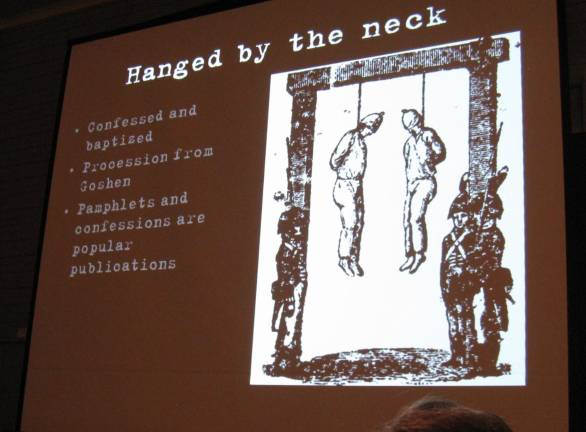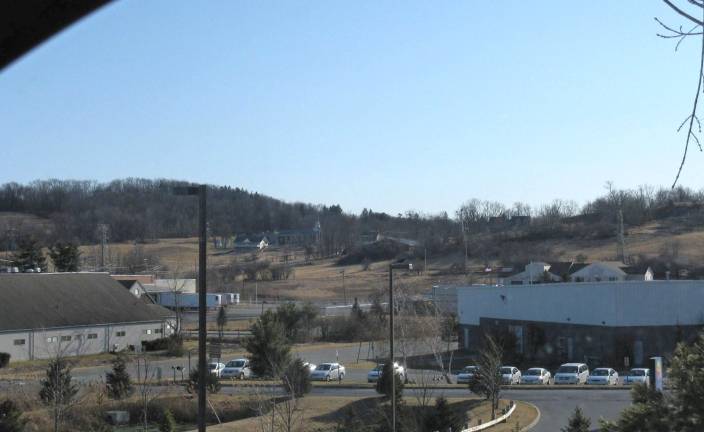Unhallowed ground


By Ginny Privitar
CHESTER — Richard Jennings was a man nobody liked. He was always bringing someone or other to court. When he was murdered on Dec. 21, 1818, at the age of 70, he was involved in a Sugar Loaf land dispute that involved several local families, all closely connected.
A modern-day detective got on the case. On Jan. 13 at the 1915 Erie Station Museum, the Chester Historical Society hosted a presentation by writer Michael Worden, a detective with the Port Jervis Police Department who used his investigative powers to bring a chapter of local history to life. He says Jennings' killing is the first murder-for-hire in New York State.
Many prominent families were connected to Jennings in some way. A young nephew, his sister's son, would become Secretary of State William Seward. A future President played an important role in the murder trial, but Worden says we’ll have to wait for his book to find out who it is.
Drastic measures
Jennings' nephew James Teed and another local man, Teed's brother-in-law David Daniel Conkling, had a running legal dispute with Jennings.
One account says Teed, following a business failure, signed a 50-acre, income-producing plot over to Conkling. The plot belong to Teed’s mother, who was Jennings' sister, Phoebe. Another account says Jennings persuaded her to sign the land over to him.
The land went back and forth. At the time of the murder, Teed, or Conkling, or both, still owned the property, but it was due to be turned over to Jennings in a month or two. In the meantime, wood was cut from the lot for income.
Teed and Conkling decided Jennings should be killed. It was Conkling's idea to get Jack Hodges — "a Negro English sailor (who) had worked for Conkling for several years...and would do most anything he asked" — drunk and give him $500 to shoot Jennings, according to report of the crime.
The conspirators had several meetings, some at a place called “the hovel” on Conkling’s land on Conklingtown Road in Goshen.
According to report of the crime, Jennings was accustomed to taking off, sometimes for days, and walking up the road, now Pine Hill Road, from his home in Sugar Loaf to his wood lot just before the Hambletonian Road split to see if any more wood had been cut. On Dec. 21 he passed Teed’s house, where the conspirators waited.
Dunning spotted Jennings passing on his way to the woodlot. He and Hodges followed him.
Hodges approached Dunning, who was arguing with Jennings. Hodges walked up and pulled the trigger. But instead of killing Jennings, he only shot off the top of his ear. Jennings fell back on the ground. Dunning then grabbed the gun and beat the old man to death with it, with many blows to the head.
Broken pieces of the stock were later found. The conspirators abandoned Jennings' body, which was soon covered with snow. It was discovered on Dec. 28.
Back at Teed’s house, the conspirators decided Hodges should hop a ship and stay away until things blew over. Hodges headed for New York harbor, crossing the Hudson at Newburgh. Meanwhile, news of the murder was spreading, helped possibly by the inebriated Hodges, who hung around Sugar Loaf for several days afterward.
Some accounts have Jesse Wood discovering the body. Others say it was Jonas Seely Jr., the original owner of famed trotting horse Hambletonian, whose farm was nearby.
Another local man, Charles B. Durland, who knew Jack Hodges, pursued and, on Dec. 31, arrested him.
Hodges soon told the whole story, implicating the others. Despite repeated re-tellings, his story never wavered.
Hanging draws 20,000 spectators
The trial in Goshen began in February 1819 and ended in March. New York's first murder-for-hire case was sensational news, drawing spectators from neighboring states.
The conspirators were found guilty and sentenced to death by hanging. But some sentences changed. Hannah Teed was sentenced to 30 days in jail.
Jack Hodges, for his testimony, was sentenced to life imprisonment at hard labor, as was Conkling.
Teed and Dunning were sentenced to hang on April 16, 1819. For days, people poured into Goshen. The authorities decided to move the execution outside the village center to accommodate the crowd, estimated at 20,000.
Accounts say the gallows was set up on Seward land near a natural amphitheater, perhaps near present-day Westgate industrial park. A great parade complete with militiamen, drums, and bugles accompanied the condemned men to the gallows. They were reportedly shackled and dressed in white to be more conspicuous. The Presbyterian Rev. Dr. Ezra Fisk preached a two-hour sermon on sin. They were finally hung by Sheriff Moses D. Burnet.
No cemetery would accept the bodies. Burial was eventually allowed on the slight rise at the entry to Sugar Loaf. According to reports, locust stakes were driven through the graves and into the bodies. Some say the stakes were visible for years.
Editor's note: This article was changed from the original to reflect further research showing that James Teed was not at the scene of the crime.